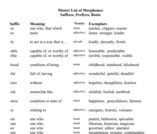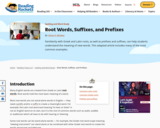
Students will explore the parts of a corn plant and their uses.
- Subject:
- Agriculture Studies
- Material Type:
- Activity/Lab
- Lesson
- Provider:
- Iowa Agriculture Literacy Foundation
- Author:
- Kelsey Faivre
- Date Added:
- 10/11/2018

Students will explore the parts of a corn plant and their uses.

The Flip-a-Chip activity provides hands-on practice with affixes and roots, and also promotes comprehension through structural analysis and vocabulary in context.

Explore this "Dear Dr. Mooney" series. Find articles on:
- Phonology - What’s That Sound I Hear?
- Morphology - Teach Your Students to be Word Detectives
- Syntax - It’s All About Understanding the Formula for English
- Semantics - Your Words Mean More Than You Think They Do
- Pragmatics - Doing Things with Language
Each article provides information, implementation strategies and links to related resources.

"BLOSSOMS video lessons are enriching students' learning experiences in high school classrooms...Our Video Library contains over 100 math and science lessons, all freely available to teachers as streaming video and Internet downloads and as DVDs and videotapes."
Learn about:
*biology
*math
*engineering
*chemistry
*physics
Select Videos (then video library), Projects or Resources (then your subject) from the top menu and the subject you'd like resource for to get started.

prefixes
suffixes
roots
syntax
examples

Familiarity with Greek and Latin roots, as well as prefixes and suffixes, can help students understand the meaning of new words. This article includes many of the most common examples.
Included in the article are downloads of Common Latin Roots chart, Common Greek Roots chart, Common Prefixes chart, Common Suffixes chart.

This article describes an approach designed to decrease math anxiety and teach students about the use of mathematical symbols simplifying radicals. A deck of cards is used in a demonstration, and a problem set using real life examples to master the use of radicals is included. This resource is from PUMAS - Practical Uses of Math and Science - a collection of brief examples created by scientists and engineers showing how math and science topics taught in K-12 classes have real world applications.

Students will strengthen their sorting skills by learning about which part of food crops they eat.

So... do plants need dirt? The truth might shock you. In this episode of Crash Course kids, Sabrina talks about how plants get energy and how that energy is transported around them. Also, she talks about dirt.